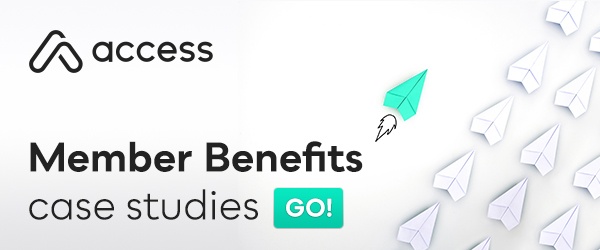20 Keys to Unlocking an Effective Member Discount Program
Not all member discount programs can really attract and engage your constituents like they promise. Here are 20 of the most important elements to look for in an effective (and compelling) discount program.
About a 4 minute read
Why are an increasing number of member-based organizations, employers, and associations providing their members with exclusive discount programs as a part of their benefits package?
Because when executed effectively, offering enticing consumer discounts has a broad appeal across all demographics, regardless of age, gender, or background.
In addition, the rule of reciprocity suggests that members are far more likely to engage with an organization if they are first offered something of significant value. Once you have successfully drawn them into your discount program, you will have a stronger advantage in maintaining their engagement with your organization in the long run.
That’s what thousands of organizations have done to boost member acquisition and customer retention.
But not all discount programs actually work. Some may appear to have what it takes to be a compelling member benefit, but they lack in some important way.
That’s why it’s important to know how to differentiate between discount programs that engage, and those that don’t.
As discount programs vary widely, when your organization is vetting member discount programs, evaluate how each program delivers on each of these key elements:
1. Is it a Closed (Password Protected) Discount Network?
Merchants strategically withhold their most enticing discounts, reserving them exclusively for closed networks where they have complete control over who can access them. The discounts offered to the general public are often lackluster and do not represent the retailer's best deals. By utilizing closed discount networks, merchants can showcase their most appealing discounts to a targeted audience.
Without the added security and exclusivity of a closed network, your membership discount program may fail to attract popular merchants, causing them to shy away from participating.
2. Are a substantial portion of their earnings derived from online transactions, insurance sales, and other avenues?
Some discount platforms don’t want you to know that their “free” or “nearly free” discount program has some hidden costs. Their business model shifts the cost burden of your so-called benefits program to the backs of your members. Frequently, it's because they have obtained their discounts from sophisticated affiliate marketing programs via an online affiliate network.
As a result, these so-called "free" programs fail to offer many, if any, of the highly sought-after in-store discount offers. This is because they are unable to generate revenue from these offers like they can from online transactions. Consequently, programs that primarily provide online discounts are frequently disregarded by members due to their perceived lack of value.
3. Does your organization's brand take center stage?
A major benefit of member discount programs are the regular, positive interactions your audience associates with your organization.
A discount program should definitely offer you the option to private label the program in your organization's name. That way, when your members save, it's your brand that gets all the credit for helping them save. Some program providers simply can't resist promoting themselves all over their web properties and apps. Don’t settle for that.
4. Are the majority of their discounts focused on in-store offers at physical retail locations?
 Although online spending is growing, still 85% of all retail purchases are made in-store. If the majority of the discount program's offerings are focused on online discounts, it may not be able to hold the attention of your members. In-store deals are where consumers typically spend their money, but many discount programs lack local brick-and-mortar offers due to the high costs associated with acquiring and maintaining them. It's important to inquire about the percentage of discounts that come from physical retail locations, where they can be redeemed at a cash register.
Although online spending is growing, still 85% of all retail purchases are made in-store. If the majority of the discount program's offerings are focused on online discounts, it may not be able to hold the attention of your members. In-store deals are where consumers typically spend their money, but many discount programs lack local brick-and-mortar offers due to the high costs associated with acquiring and maintaining them. It's important to inquire about the percentage of discounts that come from physical retail locations, where they can be redeemed at a cash register.
5. Are the discounts in close proximity to where your members live and work?
This research shows how the average consumer travels just 15-20 minutes for most of their everyday purchases. Consumers are more inclined to travel shorter distances for everyday purchases like gas or groceries, typically less than 8 minutes. However, when it comes to less frequent purchases such as a nice restaurant, a movie, auto services, or apparel, they may be willing to travel 15-20 minutes. It is crucial that the discounts offered by your discount program are conveniently located near where your members live and work. To achieve this, a comprehensive nationwide network with discounts in urban, suburban, and rural communities is necessary.
6. Are the discounts easy and convenient to redeem?
Consumers today have high expectations when it comes to convenience and ease of use. That's why it's crucial for each offer to be easily redeemable, whether it's by simply showing a coupon or using a mobile phone at the point of sale. When members are faced with complicated redemption processes or have to navigate through a sea of terms and conditions, it can be frustrating and diminish the practical value of the offer.
7. How many of the merchant offers are directly negotiated with the merchants themselves, and how many are sourced from third-party providers?
If the discount network has direct relationships with merchants, they usually score the juiciest discounts. On the other hand, if the discount platform relies on a third party, those discounts tend to be lackluster and mediocre. These kinds of discounts just won't cut it to capture and maintain the attention of your members.
8. Are the discounts unique or exclusive, or are they available to the general public?
The scarcity principle taps into the economic fundamentals of supply and demand: the more exceptional or exclusive an opportunity, the more valuable it becomes. When discounts are available to the general public, they tend to lose their appeal quickly. However, unique or "members only" discounts are generally seen as more valuable and can be a powerful tool to attract your audience. To ensure exclusivity, be sure to ask your provider if their discounts are open to the general public or not.
9. Are the discounts available at the merchants where consumers typically shop for their everyday needs?
The best member discount programs offer discounts at the places your members love to shop and on the things they already buy. Think fast food, pizza, casual dining, trendy clothing and accessories, electronics, movie tickets, car maintenance, cell phone plans, and more. These everyday items should make up the majority of the discounts in your program.
It's alright to have a few unique merchants like day spas and Jiu-Jitsu classes, but since these offers are less frequent, they should make up less than 1% of your network. These deals won't necessarily encourage your members to use the discount program regularly.
10. How deep are the discounts?
Let's face it, everyone loves a good deal or a freebie. While not every merchant can offer jaw-dropping 50% off or BOGO deals, the top-notch discount programs will have very few lackluster 5%-15% off offers. The deeper the discount, the more thrilled members will be to use the program regularly. So, keep an eye out for programs that boast an average discount of 25%-40% or more across all categories. Anything less than that simply won't pique member engagement.
11. Do they manage your member data securely and confidentially?
Ensure that your personal information is safeguarded when participating in a discount program. While some programs may require basic details such as your name and email address, others may even offer secure credit card capabilities for online purchases. It is crucial to prioritize the protection of this valuable information.
Beware of discount programs (or any member benefits programs, for that matter) that compromise your data privacy in exchange for discounts for marketing purposes. Look for discount programs with a proven track record in managing intricate security demands. These programs often work with large corporate clients that have established data security procedures and protocols. If reputable billion-dollar companies trust their data with a discount network, you can be confident in the program's reliability.
12. Do they offer instantly redeemed mobile coupons?
91% of college graduates own a smartphone. The coolest thing about mobile coupons is that you can redeem them right at the store, no questions asked. No need to buy a coupon booklet or waste time printing out coupons at home. Just whip out your phone and show the cashier the coupon. It's as simple as that!
13. Do they offer travel and other big-ticket items?
Everyday relevance is important, but let's get real - we all love those big-ticket items too! So, when you're looking for a discount program, make sure they offer deep discounts on those major purchases. I'm talking about snagging deals at places like DisneyWorld® and Disneyland® Resort - places that are increasingly hard to find discounts for.
And don't forget about discounts on hotels and car rentals. But here's the catch - those discounts need to be better than what you can find on those online travel booking engines. Oh, and while we're at it, look for discounts on new cars, auto repair, home and garden items, and more. Because let's face it, having a robust discount program means offering deals on all the things that matter to your members. It's a surefire way to prove the quality of your program and keep your members coming back for more.
14. Do they offer a merchant compliance program?
Nobody wants their members to go through the embarrassment of having a coupon rejected, especially in front of a busy line or friends. It's crucial that every merchant accepts the coupons from your discount program. However, sometimes businesses change ownership or the person at the counter hasn't been properly trained on which coupons are valid. To ensure compliance, it's important to have a good relationship between the discount program and the merchant. Without a direct relationship, members risk having a negative experience when trying to redeem a coupon.
One way to enforce compliance is by using serialized (one-time use) barcodes. These barcodes are scanned or manually entered into the cash register, ensuring that the discount is instantly and reliably applied.
15. Do they offer marketing and promotional services?
So, how are your members going to stay in the loop about all the awesome deals? Your staff shouldn't have to shoulder the burden of creating and executing a marketing strategy all on their own. A top-notch discount program will take care of promoting the network to your members through email, social media, printed materials, and more. Ongoing education is key because it takes time to get members into the money-saving groove.
Don't settle for mediocre promotion efforts. There's a direct link between effective promotion and membership discount program usage. The better the provider is at communicating relevant messages, the more your members will be motivated to take advantage of the program.
16. Do they offer high-touch, tailored customer support?
Consumers sometimes need a little hand-holding with even the best discount programs. Perhaps they need assistance downloading the mobile app, or maybe a non-tech-savvy member is looking for a specific restaurant on the discount network. Who should they reach out to? Most membership organizations are already short-staffed and lack the resources to handle these calls. However, a top-notch discount program will offer dedicated support for its members as part of its program offering. Look for seamless methods to address any issues, such as call centers, email, and real-time chat. Rest assured, help will always be just a click or call away!
17. Do they want to be a partner or just a vendor?
A successful member discount program is more than just throwing money at it. You need to find a provider who is willing to be your partner, someone who is just as committed to the success of the program as you are. Collaborate with this partner to create an amazing launch, set goals, monitor and adjust key performance indicators, and make necessary changes to the program. Whether you have monthly or quarterly calls, you should have complete trust that your partner is working behind the scenes to ensure your discount program performs at its best.
18. Do their offers require a purchase of a certificate or other multiple-step redemption process?
When it comes to a successful discount program, ease of redemption is crucial. Nobody wants to go through a complicated process to redeem a discount, as it's an experience that is easily forgotten and not worth the hassle. Take dining deal programs, for instance, where you have to purchase a coupon or certificate only to find out that redemption is difficult, time-consuming, and often disappointing. Instead, opt for a discount program that offers instantly redeemed coupons, ensuring a hassle-free experience for your members.
19. Do they charge merchants to join your discount network?
Besides making a quick buck from online transactions, some discount networks have the audacity to charge merchants for joining their network, using your organization's name as a bargaining chip. While it's important for discount networks to expand their network for your members, the real difference lies in how it's accomplished. Free programs, on the other hand, accept any merchant, often targeting small, independent businesses like massage therapists, lawyers, or multi-level marketers who have a very niche audience and limited popularity.
20. Do they have only one-off, daily deals, or do they have evergreen off ers?
ers?
Unlike those fleeting daily deals, evergreen offers are like eternal sunshine, with no expiration date looming overhead. These offers are a consumer's dream come true, available whenever they're most needed, rather than being a mere ploy by merchants to get rid of unwanted inventory.
Choose Wisely
When it comes to choosing the right discount program, there's more to consider than just whether it's free or not. Sure, free programs may seem enticing, but if you scratch below the surface, you'll realize they come with hidden costs in terms of engagement, trust, and loyalty.
Whether you're managing members, employees, constituents, or customers, it's essential to select a discount program that ticks all the boxes we've discussed earlier. By doing so, your membership benefits program will have the captivating power you desire and inspire long-lasting loyalty that will stand the test of time, not just a few fleeting weeks.
Topics: Customer Engagement, member retention, value enhancement, private discount programs, member engagement, customer loyalty, statistics, Discounts, member loyalty, VALUE ADDED BENEFITS, membership benefits programs, membership discounts
Written by: Gary Toyn






.jpeg)







Share your Comment.